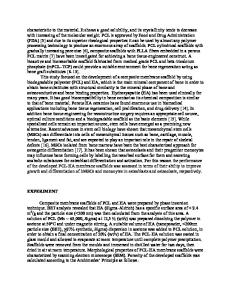Inorganic-Organic Composite Scaffolds Offer New Material for Tissue Engineering
- PDF / 50,258 Bytes
- 2 Pages / 576 x 783 pts Page_size
- 28 Downloads / 347 Views
Ultrafast Laser Radiation Generated Silicon Nanocrystals Embedded into a Glass Matrix The formation of photo-active Si nanocrystals deeply embedded in the bulk is not a trivial matter as most techniques form such nanocrystals only on the surface or shallowly embedded into the bulk. A.H. Nejadmalayeri and coworkers from the University of Toronto, Canada, together with J. Burghoff and coworkers from the Friedrich-SchillerUniversität, Jena and J. Kaspar from the Fraunhofer-Institut für Werkstoff und Strahltechnik in Dresden, Germany, reported in the December 15, 2007 issue of Optics Letters (p. 3474) the laser generation of Si nanocrystals within bulk transparent media deep below the surface. The researchers used linearly polarized mid-infrared ultrafast radiation at a wavelength of 2400 nm to propagate in the transparency window of Si. They focused the beam into Si wafers overcoated with 20-μm thick silicon oxide, and scanned the samples transversely using a motorized translation stage. The laser exposure created damage tracks along the [100] crystallographic direction at the Si/SiO2 interface, leaving the top oxide surface intact, and generated optical waveguides for 1300 nm and 1550 nm radiation with moderate losses of ~1 dB/cm. Transmission electron micrographs and diffraction patterns showed small crystallites, 5–30 nm in size, without any particular order within the amorphous oxide immediately above the silicon–glass interface. “Although Si and SiO2 are transparent to the laser radiation, the interface exhibits relatively low damage threshold due to impact ionization and/or other nonlinear interactions, that cause a rapid heating and melting of a thin Si layer at the interface, followed by the melting of the adjacent oxide. Upon cooling, the molten glass resolidifies, and the silicon droplets recrystallize, forming a heterogeneous mixture of Si nanoparticles randomly oriented in the glass,” the researchers said. The Si matrix close to the modified region was disordered and under planar compressive stress, as confirmed by Raman characterization. According to the researchers, this stress caused a density change that can induce an increase of refractive index, responsible for the optical waveguiding observed. However, the researchers still do not know if this phenomenon is a unique characteristic of the ultrashort pulsed laser interaction with the Si/SiO2 system or if it can occur in other systems like Si/Si3N4. The researchers consider the close proximity of the nanocrystals to the evanescent fields of the guided modes 78
that were observed in these structures “very interesting.” They said, “Considering the attractive luminescence properties, their proximity to such guided wave optics in a single step process suggests new opportunities to explore means of making compact Si-based light sources.” JOAN J. CARVAJAL
Boron-Doped Titanium Nitride Nanocomposite Thin Films Exhibit Broadband Photoluminescence Titanium nitride (TiN) has been used as a template to grow gallium nitride (GaN) thin films due to its high electr
Data Loading...











